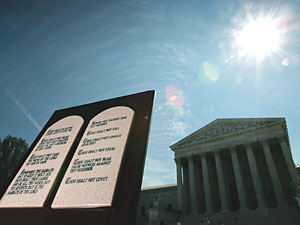|
Photos
Resources
|
June 27, 2005
A sharply divided Supreme Court on Monday upheld the constitutionality of displaying the Ten Commandments on government land, but drew the line on displays inside courthouses, saying they violated the doctrine of separation of church and state.
Washington, D.C. — A sharply divided Supreme Court on Monday upheld the constitutionality of displaying the Ten Commandments on government land, but drew the line on displays inside courthouses, saying they violated the doctrine of separation of church and state.
Sending dual signals in ruling on this issue for the first time in a quarter-century, the high court said that displays of the Ten Commandments - like their own courtroom frieze - are not inherently unconstitutional. But each exhibit demands scrutiny to determine whether it goes too far in amounting to a governmental promotion of religion, the court said in a case involving Kentucky courthouse exhibits.
In effect, the court said it was taking the position that issues of Ten Commandments displays in courthouses should be resolved on a case-by-case basis.
In that 5-4 ruling and another decision involving the positioning of a 6-foot granite monument of the Ten Commandments on the grounds of the Texas capitol, Justice Sandra Day O'Connor was the swing vote. The second ruling, likewise, was by a 5-4 margin.
Justice Antonin Scalia released a stinging dissent in the courthouse case, declaring, "What distinguishes the rule of law from the dictatorship of a shifting Supreme Court majority is the absolutely indispensable requirement that judicial opinions be grounded in consistently applied principle."
The justices voting on the prevailing side in the Kentucky case left themselves legal wiggle room, saying that some displays inside courthouses - like their own courtroom frieze - would be permissible if they're portrayed neutrally in order to honor the nation's legal history.
But framed copies in two Kentucky courthouses went too far in endorsing religion, the court held. Those courthouse displays are unconstitutional, the justices said, because their religious content is overemphasized.
In contrast, a 6-foot-granite monument on the grounds of the Texas Capitol - one of 17 historical displays on the 22-acre lot - was determined to be a legitimate tribute to the nation's legal and religious history.
"Of course, the Ten Commandments are religious - they were so viewed at their inception and so remain. The monument therefore has religious significance," Chief Justice William H. Rehnquist wrote for the majority in the case involving the display outside the state capitol of Texas.
"Simply having religious content or promoting a message consistent with a religious doctrine does not run afoul of the Establishment clause," he said.
Rehnquist was joined in his opinion by Scalia, and justices Anthony Kennedy and Clarence Thomas. Breyer filed a separate opinion concurring in the result.
The rulings were the court's first major statement on the Ten Commandments since 1980, when justices barred their display in public schools. But the high court's split verdict leaves somewhat unsettled the role of religion in American society, a question that has become a flashpoint in U.S. politics.
"While the court correctly rejects the challenge to the Ten Commandments monument on the Texas Capitol grounds, a more fundamental rethinking of our Establishment Clause jurisprudence remains in order," Thomas wrote in a separate opinion.
Dissenting in the Texas case, Justice John Paul Stevens argued the display was an improper government endorsement of religion. Stevens noted in large letters the monument proclaims 'I AM the LORD thy God."'
"The sole function of the monument on the grounds of Texas' State Capitol is to display the full text of once version of the Ten Commandments," Stevens wrote.
"The monument is not a work of art and does not refer to any event in the history of the state," Stevens wrote. "The message transmitted by Texas' chosen display is quite plain: This state endorses the divine code of the Judeo-Christian God."
Justices O'Connor, David H. Souter and Ruth Bader Ginsburg also dissented.
(Copyright 2005 by The Associated Press. All Rights Reserved.)




